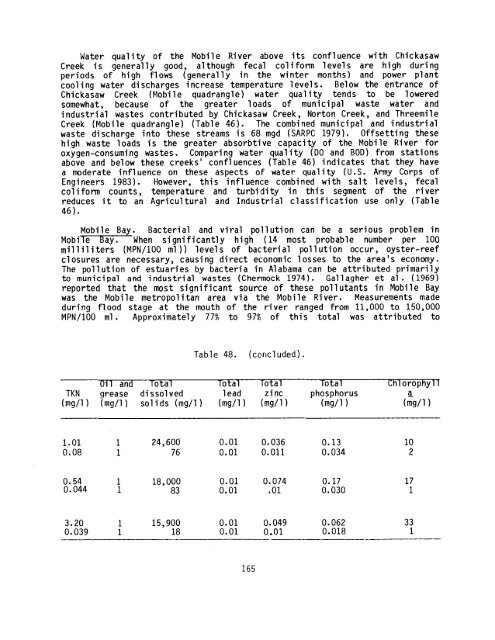ecological characterization atlas of coastal alabama - Data Center
ecological characterization atlas of coastal alabama - Data Center
ecological characterization atlas of coastal alabama - Data Center
You also want an ePaper? Increase the reach of your titles
YUMPU automatically turns print PDFs into web optimized ePapers that Google loves.
Water quality <strong>of</strong> the Mobile River above its confluence with Chickasaw<br />
Creek is generally good, although fecal coliform levels are high during<br />
periods <strong>of</strong> high flows (generally in the winter months) and power plant<br />
cooling water discharges increase temperature levels . Below the entrance <strong>of</strong><br />
Chickasaw Creek (Mobile quadrangle) water quality tends to be lowered<br />
somewhat, because <strong>of</strong> the greater loads <strong>of</strong> municipal waste water and<br />
industrial wastes contributed by Chickasaw Creek, Norton Creek, and Threemile<br />
Creek (Mobile quadrangle) (Table 46) . The combined municipal and industrial<br />
waste discharge into these streams is 68 mgd (SARPC 1979) . Offsetting these<br />
high waste loads is the greater absorbtive capacity <strong>of</strong> the Mobile River for<br />
oxygen-consuming wastes . Comparing water quality (DO and BOD) from stations<br />
above and below these creeks' confluences (Table 46) indicates that they have<br />
a moderate influence on these aspects <strong>of</strong> water quality (U .S . Army Corps <strong>of</strong><br />
Engineers 1983) . However, this influence combined with salt levels, fecal<br />
coliform counts, temperature and turbidity in this segment <strong>of</strong> the river<br />
reduces it to an Agricultural and Industrial classification use only (Table<br />
46) .<br />
Mobile Bay . Bacterial and viral pollution can be a serious problem in<br />
Mobi e Bay . When significantly high (14 most probable number per 100<br />
milliliters (MPN/100 ml)) levels <strong>of</strong> bacterial pollution occur, oyster-reef<br />
closures are necessary, causing direct economic losses to the area's economy .<br />
The pollution <strong>of</strong> estuaries by bacteria in Alabama can be attributed primarily<br />
to municipal and industrial wastes (Chermock 1974) . Gallagher et al . (1969)<br />
reported that the most significant source <strong>of</strong> these pollutants in Mobile Bay<br />
was the Mobile metropolitan area via the Mobile River . Measurements made<br />
during flood stage at the mouth <strong>of</strong> the river ranged from 11,000 to 150,000<br />
MPN/100 ml . Approximately 77% to 97% <strong>of</strong> this total was attributed to<br />
Table 48 . (concluded) .<br />
i an oa oa oT-f aT-- oa oropy<br />
TKN grease dissolved lead zinc phosphorus a<br />
(mg/1) (mg/1) solids ( mg/i) (mg/1) (mg/1) (mg/1) (mg/1)<br />
1 .01 1 24,600 0 .01 0.036 0.13 10<br />
0.08 1 76 0 .01 0 .011 0.034 2<br />
0.54 1 18,000 0 .01 0.074 0.17 17<br />
0.044 1 83 0 .01 .01 0.030 1<br />
3 .20 1 15,900 0 .01 0.049 0.062 33<br />
0.039 1 18 0 .01 0 .01 0.018 1<br />
165
















